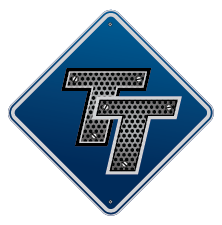Syncronizers???
Topic 11045 | Page 1
I'm not sure exactly why standard transmissions haven't had synchronizers. I can only assume it was an issue with wear because synchronizers are basically clutches as I understand them.
But yeah, it's starting to look like you'll see a major move to automatics by the majority of the large fleets in the next few years.

I actually drive a stick and honestly prefer standards. I have been practicing with double clutching and rev matching in my four wheeler..... Its not going well. Lol my brain is telling me to do one thing while my hands and feet do another
Double Clutch:
To engage and then disengage the clutch twice for every gear change.
When double clutching you will push in the clutch, take the gearshift out of gear, release the clutch, press the clutch in again, shift the gearshift into the next gear, then release the clutch.
This is done on standard transmissions which do not have synchronizers in them, like those found in almost all Class A trucks.
Double Clutching:
To engage and then disengage the clutch twice for every gear change.
When double clutching you will push in the clutch, take the gearshift out of gear, release the clutch, press the clutch in again, shift the gearshift into the next gear, then release the clutch.
This is done on standard transmissions which do not have synchronizers in them, like those found in almost all Class A trucks.

After you get rolling stop using your clutch in your car..... its all about matching the gears and engine speed then..... which is what you have to do when youre 2x clutching or "floating" gears...( wont help you get the footwork but practice in hearing the "sweet spot"
we just went through this question today in school and the answer given was that the torque of the engine basically tears the syncros out of the trans.... I wondered about it as obvious they have something sorted out with the automatics but meh I don't really need to worry about it "they dont have them so 2x clutching for the test and after that depends on company policy and equipment ....of course you can always 2x clutch

After you get rolling stop using your clutch in your car..... its all about matching the gears and engine speed then..... which is what you have to do when youre 2x clutching or "floating" gears...( wont help you get the footwork but practice in hearing the "sweet spot"
we just went through this question today in school and the answer given was that the torque of the engine basically tears the syncros out of the trans.... I wondered about it as obvious they have something sorted out with the automatics but meh I don't really need to worry about it "they dont have them so 2x clutching for the test and after that depends on company policy and equipment ....of course you can always 2x clutch
So don't use the clutch after first in my four wheeler?

Exactly... using the clutch in your car you are engaging the syncros....some trans will be more forgiving then others .... I had a Honda CRX that had lots of special toys on it ages ago and it was amazing to shift without the clutch and if it was rolling at all you could "bump it" into 1st and never touch the clutch at all...Ive also had a dodge truck that was the most difficult SOB to not grind but with practice nailed it as well....... I got in trouble today ( we got some surprise truck time. ) when I was busted not using the clutch but floating in low range going down( I had all the motions but the timing was off so when I actual hit the gear my clutch was already out ....positive side my current first choice for employer told me I'd be floating gears but I still need to get it for the test to obtain the Class A
Floating Gears:
An expression used to describe someone who is shifting gears without using the clutch at all. Drivers are taught to "Double Clutch" or press and release the clutch twice for each gear shift. If you're floating gears it means you're simply shifting without using the clutch at all.
Brett was right on the money. It's about wear and tear. Synchros are great in cars but won't endure the stress loads in the heavy duty use of a truck. You'll learn to find the sweet spot, that point where when you shift, the truck will almost suck the shifter into gear for you. You'll also learn that there's a sweet spot on both the low and high end of the tach.
I just learned double clutching today in class. I have been watching videos on you tube and my instructor taught us very well. We had 3 students in our truck today and all of us were able to up and downshift before lunchtime. Its not difficult just takes some rhythem and getting used to.
Double Clutch:
To engage and then disengage the clutch twice for every gear change.
When double clutching you will push in the clutch, take the gearshift out of gear, release the clutch, press the clutch in again, shift the gearshift into the next gear, then release the clutch.
This is done on standard transmissions which do not have synchronizers in them, like those found in almost all Class A trucks.
Double Clutching:
To engage and then disengage the clutch twice for every gear change.
When double clutching you will push in the clutch, take the gearshift out of gear, release the clutch, press the clutch in again, shift the gearshift into the next gear, then release the clutch.
This is done on standard transmissions which do not have synchronizers in them, like those found in almost all Class A trucks.
I just learned double clutching today in class. I have been watching videos on you tube and my instructor taught us very well. We had 3 students in our truck today and all of us were able to up and downshift before lunchtime. Its not difficult just takes some rhythem and getting used to.
One thing that will continue to help on your double clutch is don't use too much clutch. During the pre trip you check for the free play in the clutch. When driving, do something similar, that point where you start to feel pressure (only a couple inches on the clutch pedal) is all you need for double clutching. Granted, you're in a training truck and they're not as easy to shift as the truck you'll drive out on your own because they've been beat on 8 hours a day by students learning the process. Just keep working at it, you'll get it down in no time.
Double Clutch:
To engage and then disengage the clutch twice for every gear change.
When double clutching you will push in the clutch, take the gearshift out of gear, release the clutch, press the clutch in again, shift the gearshift into the next gear, then release the clutch.
This is done on standard transmissions which do not have synchronizers in them, like those found in almost all Class A trucks.
Double Clutching:
To engage and then disengage the clutch twice for every gear change.
When double clutching you will push in the clutch, take the gearshift out of gear, release the clutch, press the clutch in again, shift the gearshift into the next gear, then release the clutch.
This is done on standard transmissions which do not have synchronizers in them, like those found in almost all Class A trucks.
Well said robert, that was one thing our instructor was drilling in our head. down shifting was a little more difficult for me personally. but once i got a feel for how much gas to give it for the right RPM's it became much easier. that poor truck gets the **** beaten out of it. so many grinded gears day in and day out.
New Reply:
New! Check out our help videos for a better understanding of our forum features

















Preview:








 TT On Facebook
TT On Facebook
Why don't Semis have them? Seems like "old" tech now, just wondering. I guess people really love to double clutch
Double Clutch:
To engage and then disengage the clutch twice for every gear change.
When double clutching you will push in the clutch, take the gearshift out of gear, release the clutch, press the clutch in again, shift the gearshift into the next gear, then release the clutch.
This is done on standard transmissions which do not have synchronizers in them, like those found in almost all Class A trucks.